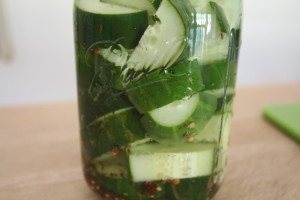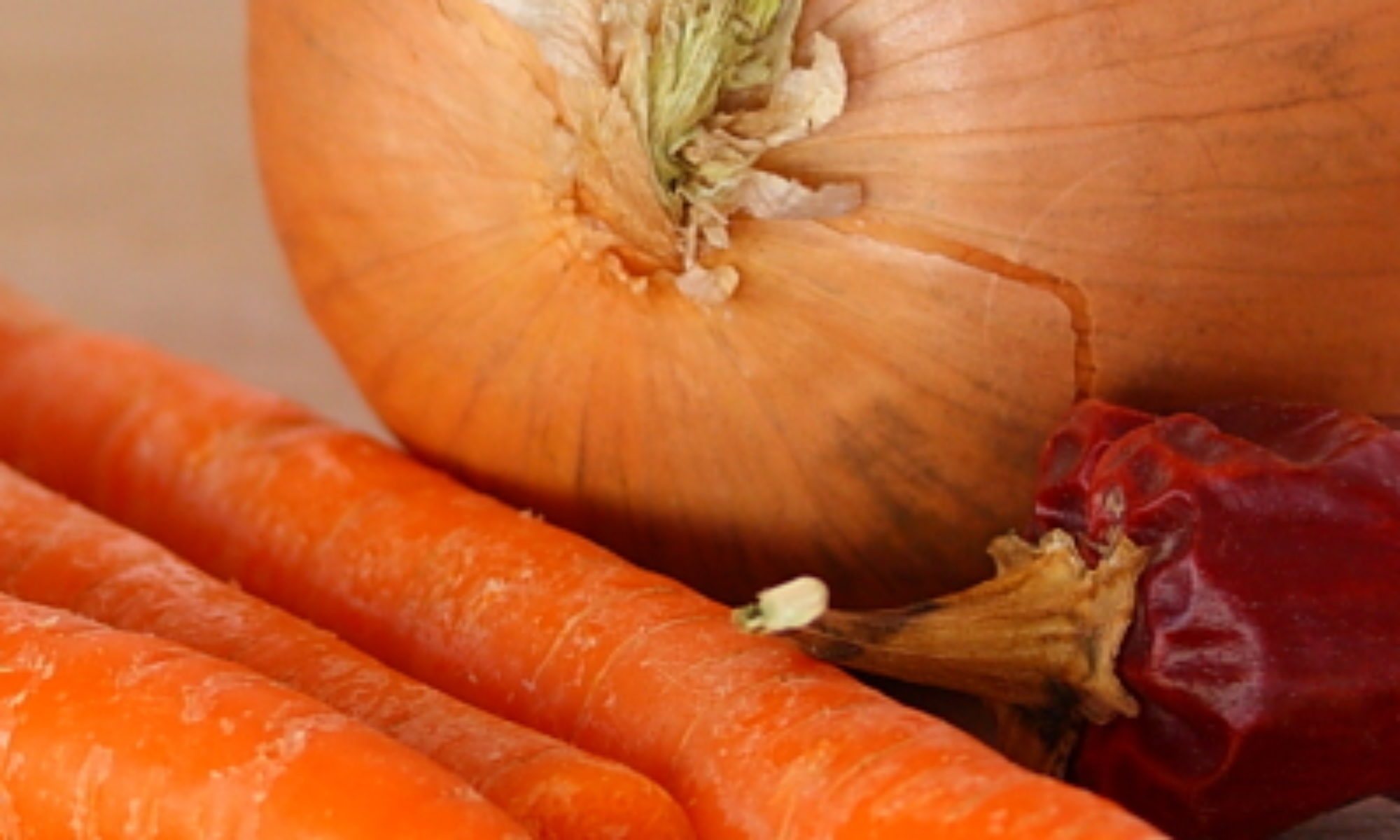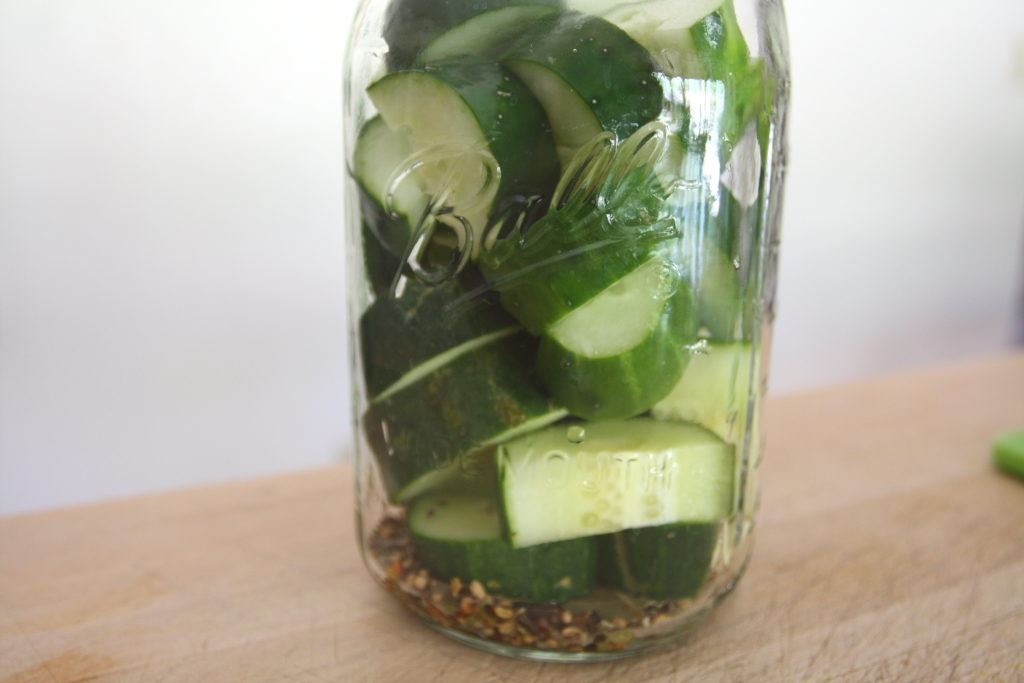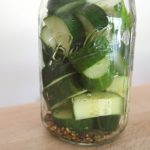
These are real pickles. Not the kind that you get in a store, but real 100% fermented pickles. The kind your grandparents (or maybe great-grandparents) made or bought. At one time, the method we’ll show was the preferred method for making pickles. But today, almost no one makes pickles with 100% fermentation anymore. Do you want to know why?
You might think that it’s because it’s difficult. Nope, it takes only five minutes of your time. You might think it’s because other methods make a better pickle. Nope, these pickles will contain all the nuanced flavors that you get from real fermentation. Perhaps it’s because the ingredients are hard to find. No, at a minimum you’ll need salt and water. Is it because it’s expensive to make pickles this way? Yes, and no. It’s expensive for factories, because the pickles have to ferment for days. That’s days they have to let cucumbers sit around taking up space. For factories, it’s easier simply to pickle cucumbers (and other products) with vinegar. Using vinegar, pickles can be in their jars and on the way to a store within hours. But, no, they’re not expensive for the home scratcher. Again, water and salt are the bare minimum you’ll need, plus a few spices. So, let’s see how to make up a batch of real pickles.
Real Pickles
Ingredients
- 1 tsp pickling spice
- 1 tsp dill seeds
- 1 bay leaf
- 1 clove garlic
- 2 cucumbers
- 1 Tbs kosher salt
- 2 cups water
Instructions
- Place pickling spice, dill seeds, bay leaf, and garlic in a 1-quart jar. Cut the cucumber into pieces, discarding ends, and place in jar.
- Combine salt and water and stir to dissolve. Pour over cucumbers, ensuring cucumbers are completely submerged.
- Place lid on the jar and let ferment at room temperature, for 8 to 10 days. Loosen lid to release the build-up of carbon dioxide, as needed.
- Place in refrigerator to stop fermentation.
Ingredient discussion:
The pickling spice, dill seed, bay leaf, and garlic are suggestions. If you have fresh dill, you can use that. If you have grape leaves, consider adding one. If you like more garlic, use more garlic. If you don’t like bay, omit. You get the idea. For salt, use kosher, as it doesn’t contain iodine, which can discolor pickles a bit.
Procedure in detail:
Place spices in jar. Wash out the jar with hot water and rinse thoroughly. No need to dry. Put the pickling spice, dill seed, garlic clove, bay leaf, or whatever you’ve chosen to add, into the jar. Simple, right?

Add cucumber. Slice off the ends of the cucumber and discard. Sometimes these are bitter, and we don’t really like bitter pickles. Cut the cukes into whatever shape you want, spears, chunks, or even leave whole, and pop them into the jar, too.
Add brine. Mix together the 2 cups water and tablespoon of salt. Stir until dissolved, then pour over the cucumbers. If needed, make more brine using the same ratio. Now for the tricky part. You need to keep the cucumbers submerged. Find something that you can place on top of the cucumbers that will hold them down, but will still allow you to close the lid. We have a tiny glass bowl that works perfectly. It’s heavy enough to hold the cucumbers down so they won’t float up to the surface.
Ferment. Cover the jar with the lid and let stand at room temperature for about 8 to 10 days. Periodically, loosen the lid to release the carbon dioxide that’s building up in the jar, a couple of times on the first and second days, then maybe once a day thereafter.
Taste. After a few days, try a pickle to see if it’s pickle-y enough for you. As the fermentation goes on, the pickles will become more sour, and only you know how sour you like them, so give them a taste. When you think they’re perfect, pop them into the refrigerator to stop the fermentation.
N.B.The pickles will get cloudy, and they might seem fizzy, but that’s the nature of fermentation. Also, note that these do need to be refrigerated once they ferment to your taste.
The second day, we knew that we’d love these pickles, as they already had a nice pickle scent and very mild taste. As you can see, making pickles the old-fashioned way is probably even easier than using vinegar — they just start fermenting all by themselves. And, you can easily swap out the spices as you see fit. We think that makes for a perfect pickle. Five tart stars.



